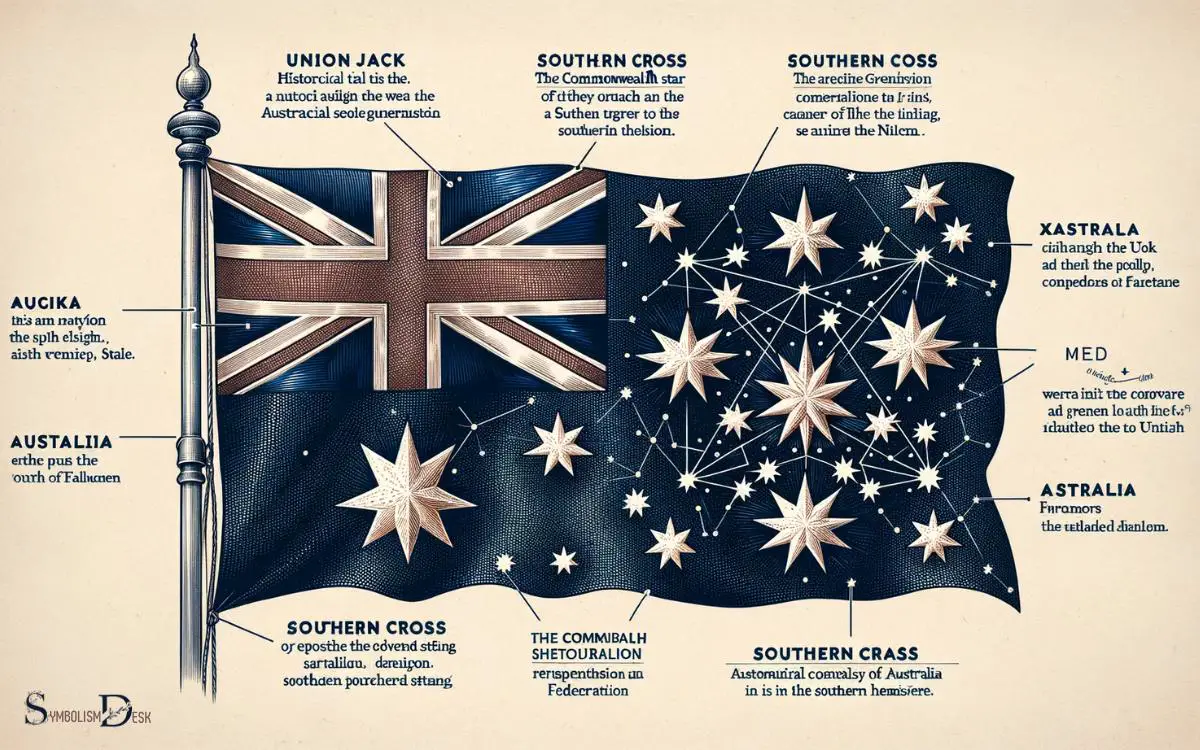What Do the Symbols Mean on the Australian Flag? Union Jack!
The Australian flag features three primary symbols: The Union Jack, the Southern Cross, and the Commonwealth Star.
These emblems represent Australia’s historical ties with the United Kingdom, its geographical location in the Southern Hemisphere, and its federal structure and unity as a nation.
The Union Jack in the upper left corner signifies Australia’s historical links to Great Britain. The Southern Cross constellation, depicted on the right side of the flag, symbolizes Australia’s geographical position in the Southern Hemisphere and serves as a navigational guide.
The Australian flag’s design eloquently communicates the nation’s past, its place in the world, and the unity of its people, making it a powerful emblem of national identity.

Key Takeaway
4 Symbols Meanings on the Australian Flag
| Symbol | Meaning |
|---|---|
| Union Jack | Represents Australia’s historical ties to the United Kingdom, as Australia was originally a British colony. |
| Southern Cross | A constellation of stars that symbolizes Australia’s geographic location in the Southern Hemisphere and its national identity. |
| Federation Star | A large seven-pointed star representing the six original Australian states and the territories of Australia, signifying the federation of these regions into one nation in 1901. |
| Blue Background | Represents the clear skies and surrounding oceans of Australia. |
Origin of the Australian Flag
The origin of the Australian flag can be traced back to the late 19th century. In 1901, Australia adopted its national flag, which was the result of a competition held to design a flag that would represent the newly federated country.
The winning design, chosen from over 30,000 entries, features the Union Jack in the canton to honor Australia’s historical ties to Britain.
The Southern Cross constellation, a prominent feature of the southern hemisphere’s night sky, appears on the right-hand side of the flag. It consists of five white stars that are representative of the states and territories of Australia.
This unique combination of symbols has come to represent Australia’s history, culture, and identity. The presence of the Union Jack on the flag reflects the country’s historical connection to Britain, which has played a significant role in shaping Australia’s heritage and traditions.
The Union Jack
The inclusion of the Union Jack on the Australian flag holds significant historical importance, as it represents the country’s colonial ties to Britain.
This symbol has sparked debates about its relevance in modern Australia and its impact on the nation’s identity.
The ongoing discussion surrounding the Union Jack reflects the complexities of Australian history and the evolving perspectives on national symbolism.
Historical Significance of Union Jack
Frequently overlooked, the historical significance of the Union Jack on the Australian flag is deeply rooted in the country’s colonial past and its ties to the British Empire.
The Union Jack, also known as the Union Flag, represents the historical connection between Australia and Britain. It symbolizes the period of British colonization and the establishment of Australia as a British colony. The Union Jack is made up of the crosses of the patron saints of England, Scotland, and Ireland, representing the unity of these nations under British rule. This flag continues to hold significance in Australia, serving as a reminder of its colonial past and the ongoing influence of British traditions and governance. The welding symbol flag meaning serves as a reminder of the enduring ties between the two countries and the shared history that has shaped Australia into the nation it is today.
The presence of the Union Jack on the Australian flag reflects the influence of British governance, law, and culture during the nation’s formative years.
The flag serves as a reminder of Australia’s colonial heritage and its subsequent evolution into an independent, multicultural nation.
Impact on Australian Identity
The presence of the Union Jack on the Australian flag has played a significant role in shaping and influencing the country’s national identity.
The inclusion of the Union Jack represents Australia’s historical ties to Britain, signifying the country’s colonial past and its status as a former British colony.
This has sparked ongoing debate about the appropriateness of the Union Jack on the national flag, with some arguing that it is a symbol of Australia’s colonial history, while others view it as a representation of the nation’s heritage and cultural links to the United Kingdom.
The ongoing presence of the Union Jack has influenced discussions about Australia’s identity, reflecting the country’s complex relationship with its colonial past and its evolving sense of national pride and independence.
Debate Over Inclusion
Amid ongoing discussions about the Australian flag, considerable debate surrounds the inclusion of the Union Jack. The Union Jack, representing the British colonial heritage, has sparked contentious debates regarding its place on the Australian flag.
Key points in the debate include:
- Historical Significance: Advocates argue that the Union Jack symbolizes Australia’s historical ties to Britain.
- Colonial Legacy: Critics argue that the presence of the Union Jack perpetuates the colonial legacy and fails to represent Australia’s identity as a modern, multicultural nation.
- Sovereignty and Independence: Some view the removal of the Union Jack as a crucial step towards asserting Australia’s sovereignty and independence.
- National Identity: There are differing opinions on whether the Union Jack accurately reflects the diverse and inclusive nature of Australia’s national identity.
The ongoing debate over the inclusion of the Union Jack has sparked a broader conversation about the representation of Australia’s identity on its flag, including the prominent symbol of the Southern Cross.
The Southern Cross
Four stars comprise the prominent constellation known as the Southern Cross on the Australian flag. This constellation holds cultural significance in Australian history and is a well-known symbol in the southern hemisphere.
The stars represent the four brightest stars in the constellation, each with its own meaning and significance.
| Star | Name | Meaning |
|---|---|---|
| Alpha | Cen | Represents the continent’s unity |
| Beta | Crucis | Symbolizes exploration and discovery |
| Gamma | Crucis | Signifies justice and equality |
| Delta | Crucis | Represents resilience and endurance |
| Epsilon | Crucis | Symbolizes the spirit of adventure |
The Southern Cross is a symbol deeply rooted in Australian identity, representing unity, exploration, justice, resilience, and the spirit of adventure. Its inclusion on the Australian flag reflects the nation’s historical and cultural ties to the southern hemisphere.
The Commonwealth Star
One significant feature on the Australian flag is the Commonwealth Star, symbolizing the federation of Australia’s six states and territories.
The Commonwealth Star consists of seven points, with one point representing each of Australia’s six states and the seventh representing its territories.
Here are some key points about the Commonwealth Star:
- The star was added to the Australian flag in 1908 to represent the federation of the six states into a single nation.
- Initially, the star had six points, but in 1908, a seventh point was added to include the territories in the federation.
- The larger point at the bottom of the star represents the state of New South Wales, the first state to be established.
- The smaller points on the star represent the other five states: Victoria, Queensland, South Australia, Western Australia, and Tasmania.
Changes to the Australian Flag
The Australian flag has a rich history that reflects the nation’s evolving identity and values. Throughout its existence, the flag has undergone several modifications, each with its own unique symbolism and significance.
Understanding these historical changes provides insight into the enduring importance of the Australian flag as a representation of the nation.
Symbolism in Flag
The Australian flag underwent significant changes in its symbolism over the years, reflecting the nation’s evolving identity and values. These alterations were made to better represent the diverse and inclusive nature of the country.
The changes in symbolism on the Australian flag include:
- Union Jack: Originally a symbol of British colonization, it now represents Australia’s historical ties to the United Kingdom.
- Southern Cross: Reflects Australia’s geographical location in the Southern Hemisphere and has been a prominent feature since the flag’s inception.
- Commonwealth Star: Originally containing six points to represent the six federating colonies, it now has seven points to include all Australian states and territories.
- Red Ensign: Previously used as the Australian civil ensign, it now represents the nation’s maritime history and achievements.
Historical Flag Modifications
Throughout the history of the Australian flag, several significant modifications have been made to reflect the nation’s evolving identity and values. The Australian flag has undergone three major changes since it was first introduced in 1901.
These modifications were made in 1903, 1908, and 1954, each time incorporating the changes in the country’s political and cultural landscape.
The alterations ranged from the addition of new stars to represent territories, to changing the design of the Union Jack to reflect a more independent and distinct Australian identity.
These modifications were crucial in symbolizing Australia’s journey towards independence and its growing multicultural identity.
| Year | Modification |
|---|---|
| 1903 | Addition of a six-pointed star to represent the Commonwealth territories |
| 1908 | Change in the design of the stars to seven points and the addition of a seventh point to the Commonwealth Star |
| 1954 | Adjustments to the Union Jack to accompany the change in shape of the stars |
These modifications not only reflect historical events but also represent the values and aspirations of the Australian people.
Symbolism and National Identity
Symbolism plays a pivotal role in shaping a nation’s identity, and the symbols on the Australian flag are no exception. Understanding the symbolism behind the flag is crucial in comprehending the values and principles that underpin the nation as a whole.
The symbols on the Australian flag represent the country’s heritage, aspirations, and beliefs, and they serve as a visual representation of its national identity.
Here are some key points to consider:
- The Union Jack: Represents Australia’s historical link to Britain.
- The Southern Cross: Symbolizes Australia’s geographical location in the Southern Hemisphere.
- National Colors: The use of blue and red reflects the country’s national colors and heritage.
- Federation Star: Signifies Australia’s six states and territories coming together as a unified nation.
These symbols collectively contribute to the rich tapestry of Australia’s national identity.
What do the Symbols Mean on the Australian Flag
The Australian flag features several symbols and elements that have specific meanings:
Union Jack: The Union Jack, which is the flag of the United Kingdom, is located in the canton (upper-left corner) of the Australian flag. It represents Australia’s historical ties to Britain as it was originally a British colony.
Commonwealth Star: Below the Union Jack, there is a seven-pointed star known as the Commonwealth Star or Federation Star.
Each point of the star represents one of the six Australian states (New South Wales, Victoria, Queensland, South Australia, Western Australia, and Tasmania), with the seventh point representing the territories of the Australian Capital Territory (ACT) and the Northern Territory.
The Commonwealth Star signifies the unity of these regions as part of the Commonwealth of Australia.
Southern Cross: The most prominent feature of the Australian flag is the Southern Cross constellation, which is located on the fly (the right-hand side) of the flag.
The Southern Cross is a prominent constellation in the Southern Hemisphere, and it symbolizes Australia’s geographic location in the Southern Hemisphere.
It is composed of five stars, with each star representing a different constellation: Alpha Crucis (Acrux), Beta Crucis (Mimosa), Gamma Crucis (Gacrux), Delta Crucis (Decrux), and Epsilon Crucis (Ecrux).
Together, these symbols on the Australian flag represent the country’s historical ties to Britain, its federal structure with states and territories, and its Southern Hemisphere location.
The flag was officially adopted on September 3, 1901, following the federation of the Australian colonies into a single nation, the Commonwealth of Australia.
Do the Symbols on the Australian Flag Have a Similar Meaning to the Symbols on the New Zealand Flag?
Both the Australian and New Zealand flags feature symbols that reflect their respective national identities. While the symbols on the New Zealand flag, such as the Southern Cross constellation, represent the country’s unique geographical location, the symbols on the Australian flag, including the Union Jack, serve as a reminder of its historical ties to Great Britain. Although both flags are distinctive, their symbols convey different meanings and histories.
What does the Symbols on the Australian Flag Mean
The Australian flag features several symbols that represent various aspects of the country’s identity and history:
Union Jack: The Union Jack, also known as the Union Flag, is the flag of the United Kingdom. It is included in the Australian flag as a reminder of Australia’s historical ties to Britain. Australia was originally settled as a British colony, and the Union Jack symbolizes this colonial heritage.
Commonwealth Star: The Commonwealth Star, also known as the Federation Star, is a seven-pointed star located below the Union Jack.
Each point of the star represents one of Australia’s six states (New South Wales, Victoria, Queensland, South Australia, Western Australia, and Tasmania) and one for the territories of the Commonwealth of Australia. This star represents the unity of these regions as a single nation.
Southern Cross: The Southern Cross is a prominent constellation seen in the Southern Hemisphere, and it consists of five stars that form a cross shape. It is one of the most recognizable features of the Australian flag.
The Southern Cross represents Australia’s geographic location in the Southern Hemisphere and is often associated with navigation and exploration.
Together, these symbols on the Australian flag reflect Australia’s historical ties to Britain, its federation as a nation, and its unique geographical position in the Southern Hemisphere.
The flag was officially adopted on September 3, 1901, and it continues to be a symbol of the country’s national identity.
Conclusion
In conclusion, the symbols on the Australian flag hold deep historical and cultural significance for the nation.
The Union Jack represents Australia’s historical ties to Britain, while the Southern Cross and Commonwealth Star symbolize the country’s geographical location and federation.
The flag serves as a powerful emblem of national identity, reflecting Australia’s past, present, and future.
As the adage goes, ‘A nation’s flag is a symbol of pride and unity, representing the values and history of its people.’






